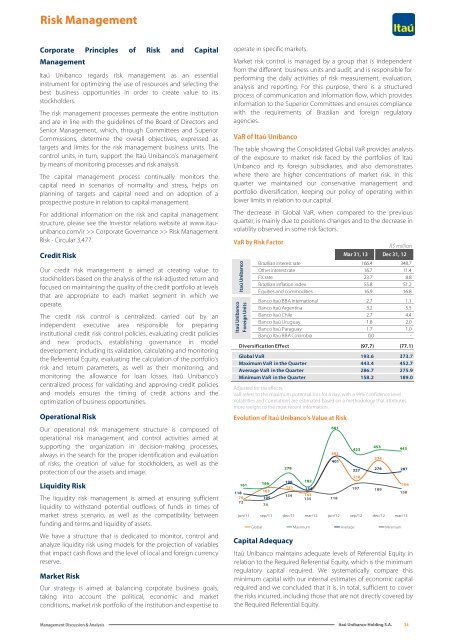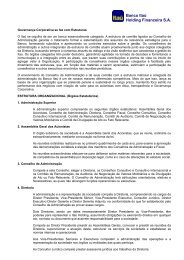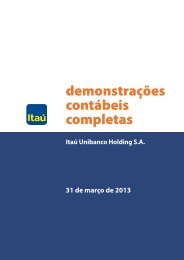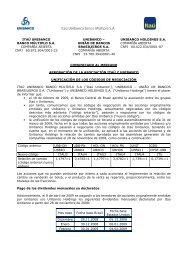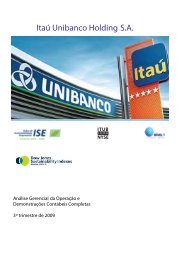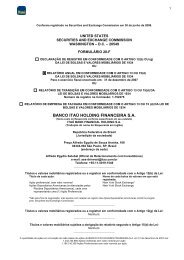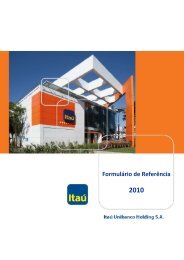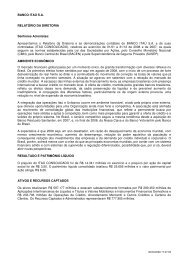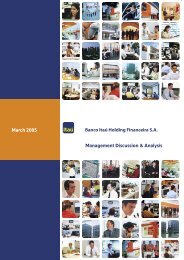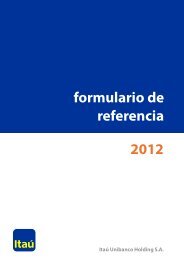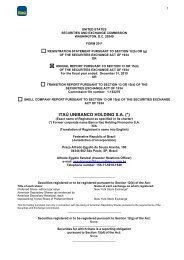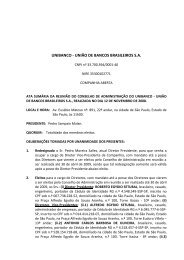IRR310313.pdf - Banco Itaú
IRR310313.pdf - Banco Itaú
IRR310313.pdf - Banco Itaú
Create successful ePaper yourself
Turn your PDF publications into a flip-book with our unique Google optimized e-Paper software.
Risk Management<br />
Corporate Principles of Risk and Capital<br />
Management<br />
<strong>Itaú</strong> Unibanco regards risk management as an essential<br />
instrument for optimizing the use of resources and selecting the<br />
best business opportunities in order to create value to its<br />
stockholders.<br />
The risk management processes permeate the entire institution<br />
and are in line with the guidelines of the Board of Directors and<br />
Senior Management, which, through Committees and Superior<br />
Commissions, determine the overall objectives, expressed as<br />
targets and limits for the risk management business units. The<br />
control units, in turn, support the <strong>Itaú</strong> Unibanco’s management<br />
by means of monitoring processes and risk analysis.<br />
The capital management process continually monitors the<br />
capital need in scenarios of normality and stress, helps on<br />
planning of targets and capital need and on adoption of a<br />
prospective posture in relation to capital management.<br />
For additional information on the risk and capital management<br />
structure, please see the Investor relations website at www.itauunibanco.com/ir<br />
>> Corporate Governance >> Risk Management<br />
Risk - Circular 3,477.<br />
Credit Risk<br />
Our credit risk management is aimed at creating value to<br />
stockholders based on the analysis of the risk-adjusted return and<br />
focused on maintaining the quality of the credit portfolio at levels<br />
that are appropriate to each market segment in which we<br />
operate.<br />
The credit risk control is centralized, carried out by an<br />
independent executive area responsible for preparing<br />
institutional credit risk control policies, evaluating credit policies<br />
and new products, establishing governance in model<br />
development, including its validation, calculating and monitoring<br />
the Referential Equity, evaluating the calculation of the portfolio’s<br />
risk and return parameters, as well as their monitoring, and<br />
monitoring the allowance for loan losses. <strong>Itaú</strong> Unibanco’s<br />
centralized process for validating and approving credit policies<br />
and models ensures the timing of credit actions and the<br />
optimization of business opportunities.<br />
Operational Risk<br />
Our operational risk management structure is composed of<br />
operational risk management and control activities aimed at<br />
supporting the organization in decision-making processes,<br />
always in the search for the proper identification and evaluation<br />
of risks, the creation of value for stockholders, as well as the<br />
protection of our the assets and image.<br />
Liquidity Risk<br />
The liquidity risk management is aimed at ensuring sufficient<br />
liquidity to withstand potential outflows of funds in times of<br />
market stress scenario, as well as the compatibility between<br />
funding and terms and liquidity of assets.<br />
We have a structure that is dedicated to monitor, control and<br />
analyze liquidity risk using models for the projection of variables<br />
that impact cash flows and the level of local and foreign currency<br />
reserve.<br />
Market Risk<br />
Our strategy is aimed at balancing corporate business goals,<br />
taking into account the political, economic and market<br />
conditions, market risk portfolio of the institution and expertise to<br />
operate in specific markets.<br />
Market risk control is managed by a group that is independent<br />
from the different business units and audit, and is responsible for<br />
performing the daily activities of risk measurement, evaluation,<br />
analysis and reporting. For this purpose, there is a structured<br />
process of communication and information flow, which provides<br />
information to the Superior Committees and ensures compliance<br />
with the requirements of Brazilian and foreign regulatory<br />
agencies.<br />
VaR of <strong>Itaú</strong> Unibanco<br />
The table showing the Consolidated Global VaR provides analysis<br />
of the exposure to market risk faced by the portfolios of <strong>Itaú</strong><br />
Unibanco and its foreign subsidiaries, and also demonstrates<br />
where there are higher concentrations of market risk. In this<br />
quarter we maintained our conservative management and<br />
portfolio diversification, keeping our policy of operating within<br />
lower limits in relation to our capital.<br />
The decrease in Global VaR, when compared to the previous<br />
quarter, is mainly due to positions changes and to the decrease in<br />
volatility observed in some risk factors.<br />
VaR by Risk Factor<br />
R$ million<br />
Mar 31, 13 Dec 31, 12<br />
Brazilian interest rate 166.4 348.7<br />
Other interest rate 16.7 11.4<br />
FX rate 23.7 8.8<br />
Brazilian inflation index 55.8 51.2<br />
Equities and commodities 16.9 16.8<br />
<strong>Itaú</strong> Unibanco<br />
<strong>Itaú</strong> Unibanco<br />
Foreign Units<br />
Adjusted for tax effects.<br />
VaR refers to the maximum potential loss for a day, with a 99% confidence level.<br />
Volatilities and correlations are estimated based on a methodology that attributes<br />
more weight to the most recent information.<br />
161<br />
118<br />
79<br />
72<br />
<strong>Banco</strong> <strong>Itaú</strong> BBA International 2.7 1.1<br />
<strong>Banco</strong> <strong>Itaú</strong> Argentina 3.2 5.5<br />
<strong>Banco</strong> <strong>Itaú</strong> Chile 2.7 4.4<br />
<strong>Banco</strong> <strong>Itaú</strong> Uruguay 1.8 2.0<br />
<strong>Banco</strong> <strong>Itaú</strong> Paraguay 1.7 1.0<br />
<strong>Banco</strong> <strong>Itaú</strong> BBA Colombia 0.0 -<br />
Diversification Effect (97.7) (77.1)<br />
Global VaR 193.6 373.7<br />
Maximum VaR in the Quarter 443.4 452.7<br />
Average VaR in the Quarter 286.7 275.9<br />
Minimum VaR in the Quarter 158.2 189.0<br />
Evolution of <strong>Itaú</strong> Unibanco's Value at Risk<br />
166<br />
163<br />
105<br />
74<br />
278<br />
198<br />
151<br />
134<br />
182<br />
154<br />
143<br />
135<br />
601<br />
402<br />
401<br />
118<br />
423<br />
327<br />
218<br />
197<br />
453<br />
374<br />
276<br />
189<br />
443<br />
287<br />
194<br />
158<br />
jun/11 sep/11 dec/11 mar/12 jun/12 sep/12 dec/12 mar/13<br />
Global Maximum Average Minimum<br />
Capital Adequacy<br />
<strong>Itaú</strong> Unibanco maintains adequate levels of Referential Equity in<br />
relation to the Required Referential Equity, which is the minimum<br />
regulatory capital required. We systematically compare this<br />
minimum capital with our internal estimates of economic capital<br />
required and we concluded that it is, in total, sufficient to cover<br />
the risks incurred, including those that are not directly covered by<br />
the Required Referential Equity.<br />
Management Discussion & Analysis<br />
<strong>Itaú</strong> Unibanco Holding S.A.<br />
34


